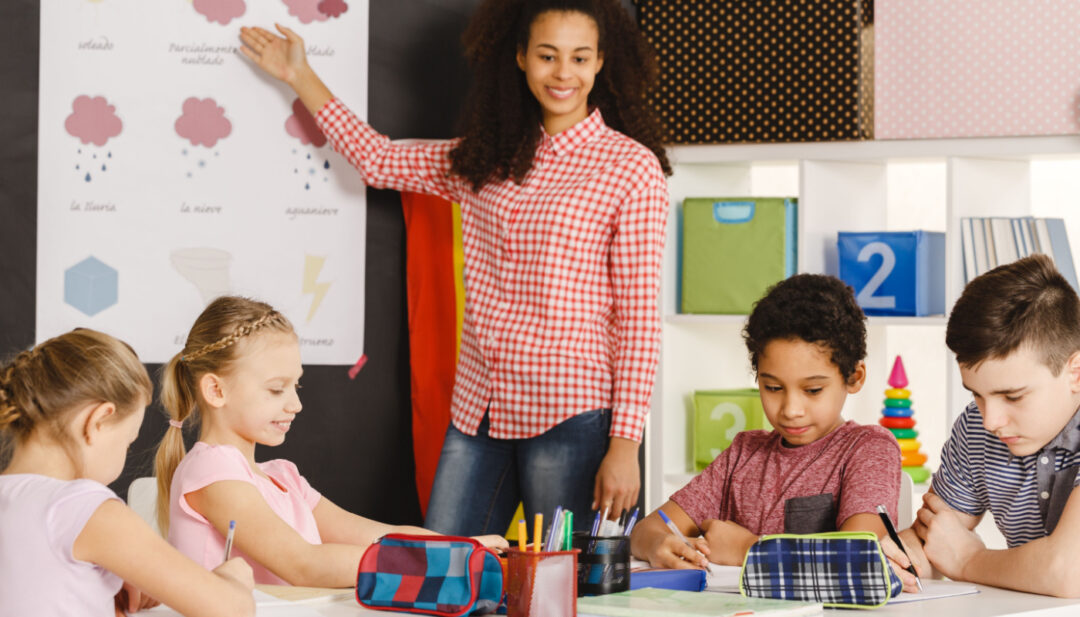
Teachers often connect their lesson plans to real world concepts. It’s easier to engage students if they can tie various ideas to their own life experiences. This makes weather lesson plans easier because most kids have been caught in a downpour, experienced a blizzard or complained about the heat.
Weather lesson plans often start with discussions about these experiences and then lead into the science behind them. If you have students who constantly ask “why” or “how,” they’ll love learning about the weather. Here are some lesson plan ideas and resources for your classroom.
Intro to Weather
It doesn’t matter where you live, the weather is all around you. You can start each day talking about the weather or set up outdoor excursions to observe seasonal changes with your students. This is a great way to highlight how a concept learned at the start of the year can be used through fall, winter and spring.
“The weather offers so many opportunities for teaching students about the seasons through charting, analysis, and reflections,” writes Kathy Y. Stovall, an education consultant. “Students can chart the weather for the first week of each month and then analyze how it changes each month and within the season.”
Stovall says this was a useful morning warm-up for her elementary students when she was teaching. They would start the day thinking about their communities and ask questions like why the weather changed so abruptly.
The team at Science Buddies has a tutorial for making your own weather station. This is appropriate for third-grade students but can be accommodated for older and younger children. Students track and record different weather patterns and learn to predict future storms or periods of dryness. Your students can give weather presentations at the end of this lesson.
Tracking the weather incorporates real-life science into your math lesson plans. Students can track the percentage of days that it rained during the school year, calculate the probability of sunshine on any given day, and apply a variety of math concepts to the weather data they collected.
Of course, you can’t talk about the weather without reading one of the best books on the subject: “Cloudy With A Chance Of Meatballs” by Judi Barrett. When kindergarten teacher Greg Smedley-Warren reads this book to his students, he dresses the part. He’s even designed a classroom setup complete with inflatable donut, pineapple, and burrito pool toys. This playful approach combines reading comprehension with science topics as very young students track the weather and report on it daily.
The science behind weather can be tied into almost any other subject your students are learning, including reading, math, history, art, and gym class.

Thunderstorms and Clouds
Students tend to have strong opinions about thunderstorms. Some are afraid of thunder; others hate how rainy days prevent them from enjoying recess. You can take these emotions and tap into the natural curiosity of learners in your lesson plans.
Astrophysicist Matt Bobrowsky shares several lesson plans related to storms in an article at the National Science Teaching Association. For example, you can talk about why you see lightning first and then hear thunder later — then you can calculate how far away the storm is using this information. This is also a great opportunity to bust the myth of heat lightning.
Depending on where you live, you might want to branch out to cover different types of storms. National Geographic created lesson plans for students in grades 5-12 that cover the different types of clouds and their variations. You can talk to your students about warm fronts or share stories about past blizzards. There are plenty of other weather resources from Nat Geo as well.
Of course, every storm has to end at some point. After the rain, it’s time to talk about rainbows, sunshine and the clouds that keep you cool. Teacher Sarah Price at Priceless Ponderings has a variety of cloud activities for the grades two and three classrooms. From cloud sculpting to cloud spotting, your students can learn the difference between cirrus, cumulus, stratus, and every cloud in between.
Extreme Heat
Weather isn’t just rain and snow. A sunny day has different temperatures, humidity levels and wind patterns. You might decide to talk about extreme heat with your kids to talk about weather safety.
In a lesson plan at ScienceNewsLearning, students are asked to read an article called “Humans may not be able to handle as much heat as scientists though.” A discussion guide for teachers is included to talk about the information. Points include how extreme heat affects the body, how the human body stays cool, and the body’s tolerance for heat stress. This could be a good opening article to foster reading comprehension and build curiosity around climate discussions.
In almost any place in the country, kids will experience high heat levels in the summer which might impact how they can play. Older students might participate in sports or have jobs where they are required to be outside for several hours. Talk to your classroom about staying safe in extreme heat. In her article, Erin Chan Ding at The Washington Post includes several expert opinions on keeping kids safe that you can review with your students and share with their parents.
But you don’t want to frighten students about climate change. Los Angeles Times science reporter Tony Barboza says he’s anxious when talking to his kids about climate change. Even with his expertise, he has a hard time talking to his elementary school-aged children about the human impact on the environment. He offers this advice:
“Break down the science in simple, understandable ways. Listen to their fears and hopes, and acknowledge your own. Explain to them that there are solutions.”
It’s easy for adults to get overwhelmed by climate discussions, especially when living through the stress of extreme heat waves. Talking about extreme heat can be an opener for bigger discussions about climate change for students of all ages, but these talks still need to be handled delicately.

Hurricanes and Tropical Storms
There are times when your lesson plans get derailed and you need to discuss current events in terms of weather and its impact on communities.
For example, Jeremy Engle and Michael Gonchar at The New York Times created a guide for teachers to talk about Hurricane Ian and its impact on Florida in 2022. It helps teachers answer difficult questions, lead discussions, and tie the event into weather-focused lessons. The guide can also be applied to almost any storm.
More recently, your students might have questions about the smoke that covered Canada and parts of the United States (turning the New York City sky orange) during the wildfires of 2023. These discussions can be learning experiences.
Your classroom might be one of the best places to talk about natural disasters. You can provide authoritative responses and lessons for students who might have experienced some of these weather elements firsthand.
“No matter what classroom or school you are in, there is always a threat of a natural disaster of some kind within your area,” says upper-elementary teacher Chloe Campbell. “Whether it is a flood, hurricane, or tornado, children need to learn about each one and know exactly what causes them and how to be prepared.”
You can create a safe place to talk about storms, ask questions, and share experiences when there aren’t any threats nearby. This allows students to learn about the potential weather events in the area so they understand what is happening (and what to do) when one is approaching.
The team at Science Explorers provides a great introduction to hurricanes for kids who are just learning about them. You can talk about how hurricanes are named, the different categories of storms, and the difference between a hurricane, tropical storm, and depression. If you live in a hurricane-prone area (or near one), you might talk about hurricane preparedness and what families should keep in their at-home kits. The names and predictions for hurricane season are usually released in early spring, to guide your lesson plan timing.

Additional Weather Resources
There are lots of resources you can turn to if you want to engage students in weather discussions or share websites for students to learn more when they are at home. Here are a few pages to bookmark when you need last-minute lesson plans.
The National Oceanic and Atmospheric Administration has dozens of lesson plans you can use to teach your students about the weather. They are sorted into different categories like clouds, the atmosphere, and tropical storms. In one lesson, students learn how much water a cloud can hold. Something that looks light and fluffy might actually contain millions of gallons of water.
Don’t forget to check out one of NOAA’s six major Line Offices, the National Weather Service, to learn about Severe Weather Preparedness/Awareness Weeks in your area. These usually fall in March and can vary by state. (If the NWS doesn’t have anything related to your state, run a Google search for regional events.) Each day covers a different type of weather — from tornadoes to flooding — and how to prepare for each one. You can use these days to guide your lesson plans and have open discussions with students.
My NASA Data is another outstanding resource for reliable, weather-related lesson plans. More advanced learners can use it to cover difficult Earth science subjects. They can learn about the geosphere (solid portions of the Earth) or the cryosphere (where water is in its solid form). There are also opportunities to visualize data to better understand it.
Even if you have a dedicated series of lessons for weather marked in your curriculum, your students can derail your plans with questions about the weather. They might ask about lighting during a stormy day or wonder why high temperatures caused you to hold recess indoors. By keeping a few lesson plans on hand, you can turn curious weather questions into learning opportunities.
Images used under license from Shutterstock.com.

